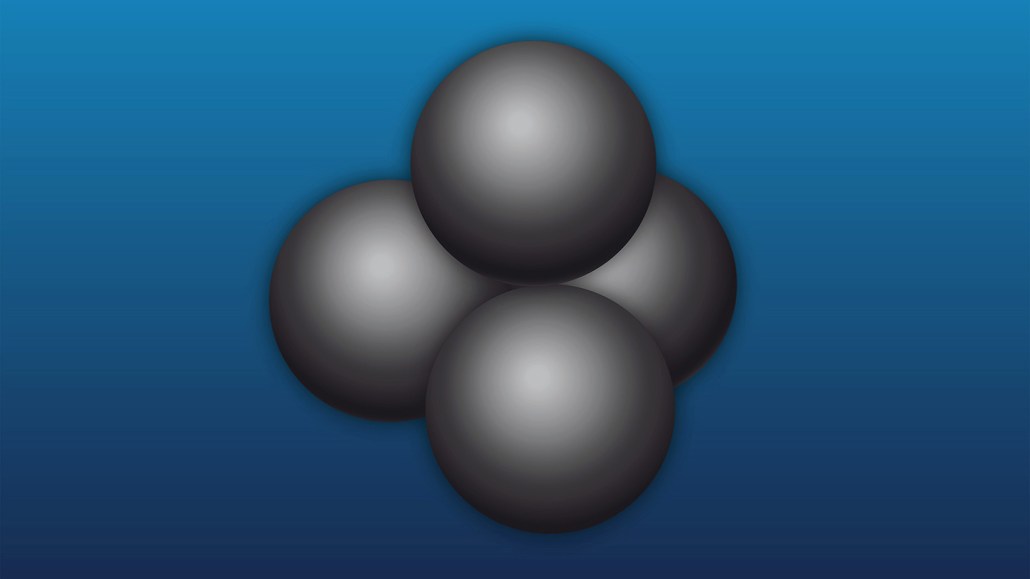
Four neutrons may form a short-lived agglomeration called a tetraneutron (illustrated).
Sonja Battenberg/TUM
- More than 2 years ago
Physicists have found the strongest sign yet of a fabled four of a kind.
For six decades, researchers have hunted for clusters of four neutrons called tetraneutrons. But evidence for their existence has been shaky. Now, scientists say they have observed neutron clusters that appear to be tetraneutrons. The result strengthens the case that the fab four is more than a figment of physicists’ imaginations. But some scientists doubt that the claimed tetraneutrons are really what they seem.
Unlike an atomic nucleus, in which protons and neutrons are solidly bound together, the purported tetraneutrons seem to be quasi-bound, or resonant, states. That means that the clumps last only for fleeting instants — in this case, less than a billionth of a trillionth of a second, the researchers report in the June 23 Nature.
Tetraneutrons fascinate physicists because, if confirmed, the clusters would help scientists isolate and probe mysterious neutron-neutron forces and the inner workings of atomic nuclei. All atomic nuclei contain one or more protons, so scientists don’t have a complete understanding of the forces at play within groups composed only of neutrons.
Sign up for our newsletter
We summarize the week's scientific breakthroughs every Thursday.
Conclusively spotting the four-neutron assemblage would be a first. “Up to now, there was no real observation of … such a system that is composed only from neutrons,” says nuclear physicist Meytal Duer of the Technical University of Darmstadt in Germany.
To create the neutron quartets, Duer and colleagues started with a beam of a radioactive, neutron-rich type of helium called helium-8, created at RIKEN in Wako, Japan. The team then slammed that beam into a target containing protons. When a helium-8 nucleus and proton collided, the proton knocked out a group of two protons and two neutrons, also known as an alpha particle. Because each initial helium-8 nucleus had two protons and six neutrons, that left four neutrons alone.
By measuring the momenta of the alpha particle and the ricocheting proton, the researchers determined the energy of the four neutrons. The measurement revealed a bump on a plot of the neutrons’ energy across multiple collisions — the signature of a resonance.
Particle smashup
Physicists collided a helium-8 nucleus with a target proton and measured the momenta of the ricocheting proton and an escaping alpha particle — a clump of two neutrons and two protons. Those measurements revealed signs that the four neutrons released in the smashup formed a long-sought cluster called a tetraneutron.

In the past, “there were indications, but it was never very clear” whether tetraneutrons existed, says nuclear physicist Marlène Assié of Laboratoire de Physique des 2 Infinis Irène Joliot-Curie in Orsay, France. In 2016, Assié and colleagues reported hints of only a few tetraneutrons (SN: 2/8/16). In the new study, the researchers report observing around 30 clusters. The bump on the new plot is much clearer, she says. “I have no doubts on this measurement.”
But theoretical calculations of what happens when four neutrons collide have raised skepticism as to whether a tetraneutron resonance can exist. If the forces between neutrons were strong enough to create a tetraneutron resonance, certain types of atomic nuclei should exist that are known not to, says theoretical nuclear physicist Natalia Timofeyuk of the University of Surrey in Guildford, England.
Because of that contradiction, she thinks that the researchers have not observed a true resonance, but another effect that is not yet understood. For example, she says, the bump could result from a “memory” that the neutrons retain of how they were arranged inside the helium-8 nucleus.
Other types of theoretical calculations are a closer match with the new results. “Indeed, theoretical results are very controversial, as they either predict a tetraneutron resonance in good agreement with the results presented in this paper, or they don’t predict any resonance at all,” says theoretical nuclear physicist Stefano Gandolfi of Los Alamos National Laboratory in New Mexico. Further calculations will be needed to understand the results of the experiment.
New experiments could help too. Because detecting neutrons, which have no electric charge, is more difficult than detecting charged particles, the researchers didn’t directly observe the four neutrons. In future experiments, Duer and colleagues hope to spot the neutrons and better pin down the tetraneutrons’ properties.
Future work may reveal once and for all whether tetraneutrons are the real deal.







